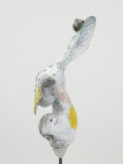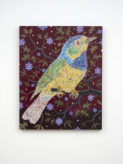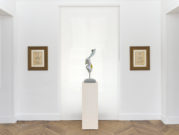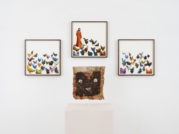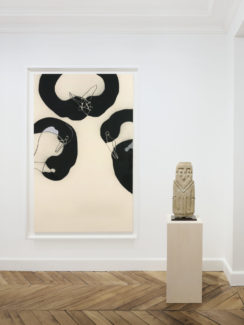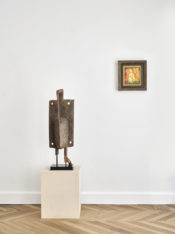Dear Shaded Viewers,
Jerry Stafford was one of the first people I met when I moved to Paris 32 years ago and I must admit that I had no idea about his obsession with birds that started at the age of six when his flamboyant uncle introduced him to their exotic existence.
White Cube Paris presents ‘Rara avis’, a group exhibition curated by Jerry Stafford. Antiquities and artefacts mix with contemporary works of and about birds.
‘The curator’s lifelong fascination with ornithology is rooted in personal narrative; from the bird as a private symbol of escape from repression, to the myths of Icarus and Ganymede which coloured his adolescent dreams and fantasies. Taking this as its point of departure, the exhibition explores the avian as messenger and polysemous signifier through selected works spanning different cultures and moments in time.
Exhibited artists: David Altmejd, Michael Armitage, Julie Curtiss, Peter Doig, Jón Einar Björnsson, Tracey Emin, Max Ernst, Leonor Fini, Masahisa Fukase, Behnaz Ghasemi, John Gould, Noel Grunwaldt, Iris van Herpen, Gary Hume, Sam Lee, Harumi Klossowska de Rola, James Merry, Joan Miró, Isamu Noguchi, Eddie Peake, Pablo Picasso, Ugo Rondinone, Pietro Ruffo, Victor Seaward, Raqib Shaw, Kiki Smith, Fred Tomaselli, Nicola Tyson, Nico Vascellari, Danh Vo; and Byzantine, Egyptian and Hellenistic antiquities, as well as artefacts from Nazca, Senufo and Valdivia cultures.
‘Birds are performance artists, shapeshifters, global ambassadors, messengers between worlds, musical maestros and biological miracles, whose often evasive or half-glimpsed presence permeates not only our daily lives but speaks to our subconscious wanderings too.’ – Jerry Stafford, 2022
“Ask not what is that bird?, but who is that bird?
Who is that bird whose skull was found in an ancient grave among human skulls, and
into whose empty eye-sockets round pebbles had been set, so that in this lightless place you stared stony and sightless right through the veil and into the ink-dark waters that
lie beyond the final pale?
I am Diver, asker –– I am Immer-Goose, carrier of souls and crosser of thresholds.
Who is that bird whose high eerie cry bubbles like water in air, glistening on the moor or down by the estuary where dawn sun turns mudflats to pewter? It shivers the spine, that cry, for sure, but it’s hard to say if it’s haunting or joyful, for it hovers in between –– though the heart knows how to hear it.
I am Curlew, asker –– I am whaup or corliu; the messenger bird, whose bill is the slender curve of the new-moon’s crescent.
Who is that bird far out on the ice of the frozen lake, vast wings draped around it like a surplice, tearing at a carcass, dropping its head, bent to its work? Who is that bird whose bones were found in a chambered tomb on Orkney –– a room of the dead, a cairn of the erne, an eerie sky-burial, deep in the dark?
I am White-Tailed Eagle, asker –– of the eight-foot wingspan, the butcher’s talons and the gristle-cleaving beak. I watched humans arrive and I will watch them leave.
Who are those birds who form a squabbling rabble of grey-brown faces, a street-gang of urchins, a riffraff of squatters and chatterers, a bevy of punters placing bets at the races, who sleep where clematis creeps and bramble loops, who nests any-old-how in holes in walls and gaps in roofs, in thatch and thorn-bush, barn and factory, in nook and in cranny, carrying on a day-long, night-long hootenanny?
We are Sparrows, little Sparrows, asker –– we have been your neighbours since far back,
deep back, in human time, darting through your caves, your mead-halls, your shopping malls.
Who is that bird who sleeps on the wing, who crosses desert, sea and mountain-top and back each year without fatigue, without flag; who lives beyond the resistance of all earthly drag?
I am Swift –– crossbow notched with arrow –– and I harrow the skies in my hooligan gangs, shredding the air with my fellow handbrake-turners, wheelie-pullers, firers-up of the afterburners, like the havoc-wreaking, thrill-seeking spring-harbingers we are.
Who is that bird who nests raucous in the tops of trees; lodged near farms and barns, towns and highways, keeping up a full-force canopy-chorus of alarums and harum- scarums, of rattles and sprees, of wheeling, crying flight –– as if a skyful of shadows had been flung up fast to block the light?
Oh I am Rook, asker –– everyday crook, hawker of goods, cooker of books; Rook, Rook, of the bald white bill and the barefaced cheek; Rook, Rook, black-marketeer of the rocking, stocky, blocky gait; I make three hops forwards, then one away.
And who is that bird who hovers gyroscope-still above the meadow, wings wide, tail feathers flared like a hand of cards; a tilted rood, a shimmering crucifix?
I am Kestrel, of the terracotta back and the ash-grey head, and they call me wind-hover, wind-rider and wind-fucker, for I can hold myself flutteringly steady in the teeth of a gale –– then fold and fall in a flash of hook and nail.
Then Diver, Curlew, Eagle, Sparrow, Swift, Rook and Kestrel all ask together:
Who is that human, who thins out the skies and fells the forests, who harvests us –– from first cut to final gleaning –– for skin and feather, meat and meaning?
And I find I have no good answer I can give.”
– Robert Macfarlane
Text © Robert Macfarlane
Robert Macfarlane is a British author and academic. He is an author of prize-winning books on the themes of memory, landscape, nature, environmentalism and travel and regularly writes for publications including the Guardian and the Times
‘As a child growing up in the London suburb of Bromley, I had a particularly flamboyant uncle who, in the 1960s, settled in the city of Jos, the administrative capital of Plateau State in the Middle Belt of Nigeria, as a curator for the anthropological museum. One Christmas he sent me two volumes of the English ornithologist David A. Bannerman’s The Birds of West and Equatorial Africa (1953). Nigeria and its birds became the signifier for me of another world. Birds were, as Claude Lévi-Strauss remarked, ‘good to contemplate’, and the exquisitely rendered drawings within these pages, like fetishes worshipped in the dark of the night, were a secret portal into another world. In my prepubescent subconscious, such fantasies merged with the mythological figures. of Icarus and Ganymede; fantastical males who haunted my dreams, symbols of escape and sexual repression. Like Ganymede I longed to be carried away by a powerful eagle or, like Icarus, to fly close to the sun and its pulsing flame.
As I continued my academic studies I was increasingly drawn to the representation of birds in art; from prehistory, antiquity and animist cultures, the avian signifiers of the Renaissance, and the 17th century Dutch and French masters through to the mystery and metaphysics of the Surrealists as well as modern and contemporary art. The figure of the cosmic divinity Horus, Fabritius’ martyred goldfinch, the Zen presence of the crane in oriental art, the polymorphic fantasies of Max Ernst and Leonora Fini or Constantin Brancusi’s distillation of avian forms, all of these and many more have inspired and influenced my own sensorial and intellectual perception as I have travelled the world in search of birds.
As a symbolic or mythological figure, the bird has been present in pre-social and classical art for centuries, but the exhibition ‘Rara avis’ also addresses the sociological, ecological and geopolitical resonance of its presence within the work of contemporary artists and our continued fascination with its transgressive magic. Birds are performance artists, shapeshifters,
global ambassadors, messengers between worlds, musical maestros and biological miracles whose often evasive or half glimpsed presence and significance underscores not only our daily lives but also our subconscious wanderings.’
– Jerry Stafford, February 2023
Installation images:
Rara avis, curated by Jerry Stafford
White Cube Paris, 3 March – 8 April 2023, © the artists. Photo © White Cube (Fabrice Gousset)
Later,
Diane
Admission to White Cube is free and the gallery is open Tuesday-Saturday 11am -7pm.
10 avenue Matignon 75008 Paris www.whitecube.com


